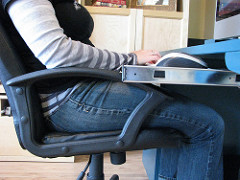You’ve heard the term ergonomic before. Maybe you have an ergonomic chair in your home or office.
But what exactly does ergonomic mean? Ergonomics is the science behind creating the optimal environment where people and items can interact safely and efficiently.
What makes an ergonomic environment depends on the person. An ergonomic office for a tall person, for instance, would differ from that designed for a short person. Your ergonomic chair, then, is designed to provide comfort and help you avoid stress and injury, but ergonomics is spread much further than furniture. How can your lifestyle benefit form an ergonomic environment both at home and at your place of work? Read on to find out.
 (JoelandMandy/Flickr)
(JoelandMandy/Flickr)
Ergonomic Benefits for the Body
As the
Occupational Health and Safety Administration (OSHA) reports, cumulative trauma disorders (CTDs) are on the rise thanks to workplace ergonomic hazards. In fact, they report that CTDs “represent nearly half of the occupational illnesses reported in the annual Bureau of Labor Statistics (BLS) survey.”
Ergonomic injuries are easy to overcome once you recognize the problem behind them. Wrist pain, for instance, can be avoided by using an ergonomic keyboard. An ergonomic kitchen environment will reduce how often you bend down to retrieve ingredients and supplies to decrease the chance of injury.
Essentially,
a good ergonomic environment is designed so that you feel better on a physical level, whether it’s in an ergonomic chair that reduces spinal pressure or it’s installing your kitchen countertops at a comfortable height based on your own preferences.
Ergonomic Benefits for the Mind
When your body feels great, you feel great. Now that you’re living in an optimal environment—which will help reduce pain and pressure on different areas of the body—you’ll feel more energized to do the things you want to do. An ergonomic keyboard that relieves your wrist pain, for example, will help you get back into crocheting because it doesn’t hurt to work that needle anymore. Having this newfound energy will improve your quality of life and put a smile back on your face!
But an ergonomic environment does so much more than that. As an
article on the National Center for Biotechnology Information website points out, an effective occupational ergonomics program in the workplace not only focuses on physical demands but also on aspects like understaffing, quality of supervision, and work scheduling. Working with a company that focuses on these ergonomic factors can help reduce stress. In turn, this benefit can work its way back into a healthier body by promoting better sleep and reducing your chance of health issues like heart disease and obesity.
Ergonomic Benefits for the Wallet
Leading a happier, healthier life makes sense when you’re living in an ergonomic environment, but did you know it has practical benefits on your financial situation as well?
How? First of all, since an ergonomic environment is designed to reduce injury, you save money on any medical bills related to ergonomic injuries, or CTDs. Some common injuries that can rack up the health bills include tendonitis, carpal tunnel, and lower back issues.
Not only are you saving on medical bills, but since you’re spending less time at doctor’s appointments and in recovery, you have more time to work, which can boost your paycheck. But what if you’re using your paid vacation to take those doctor’s appointments? Wouldn’t it be great to take a real vacation instead—therefore boosting your quality of life?
Additionally, with more motivation and a better morale, you’re more productive, which puts you in a better position to make more money if you’re paid on a per-project basis. This is a great incentive for freelancers to invest in an ergonomic workspace and home.
An ergonomic environment isn’t about improving just one factor of your life—whether it’s your body, mind, or wallet. Each area of your life can impact the others, and an ergonomic space can get this cycle started. Now that you’re familiar with the benefits of ergonomics both at home and at the workplace, how will it impact how you design your environment?